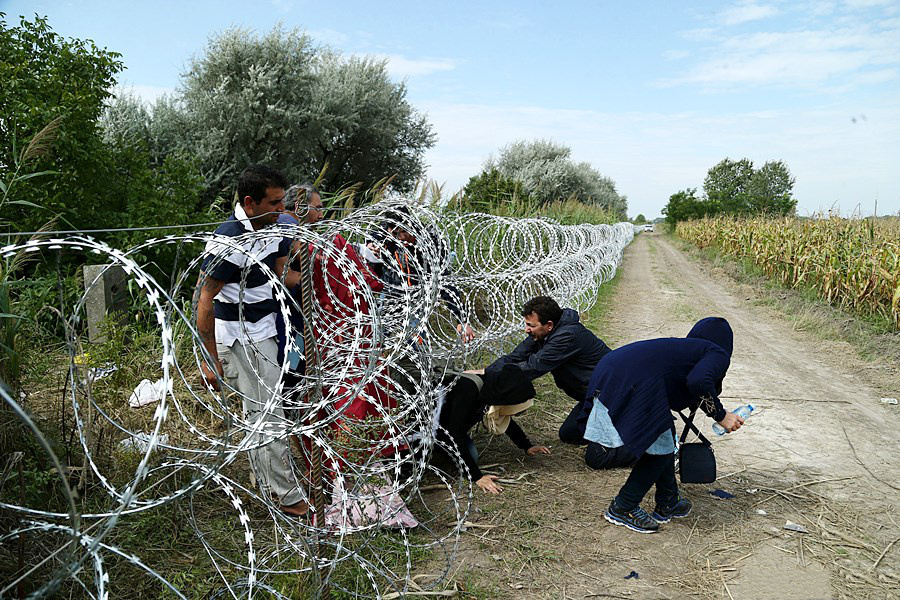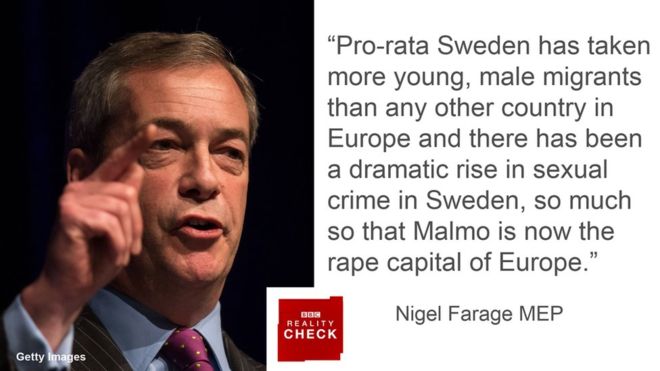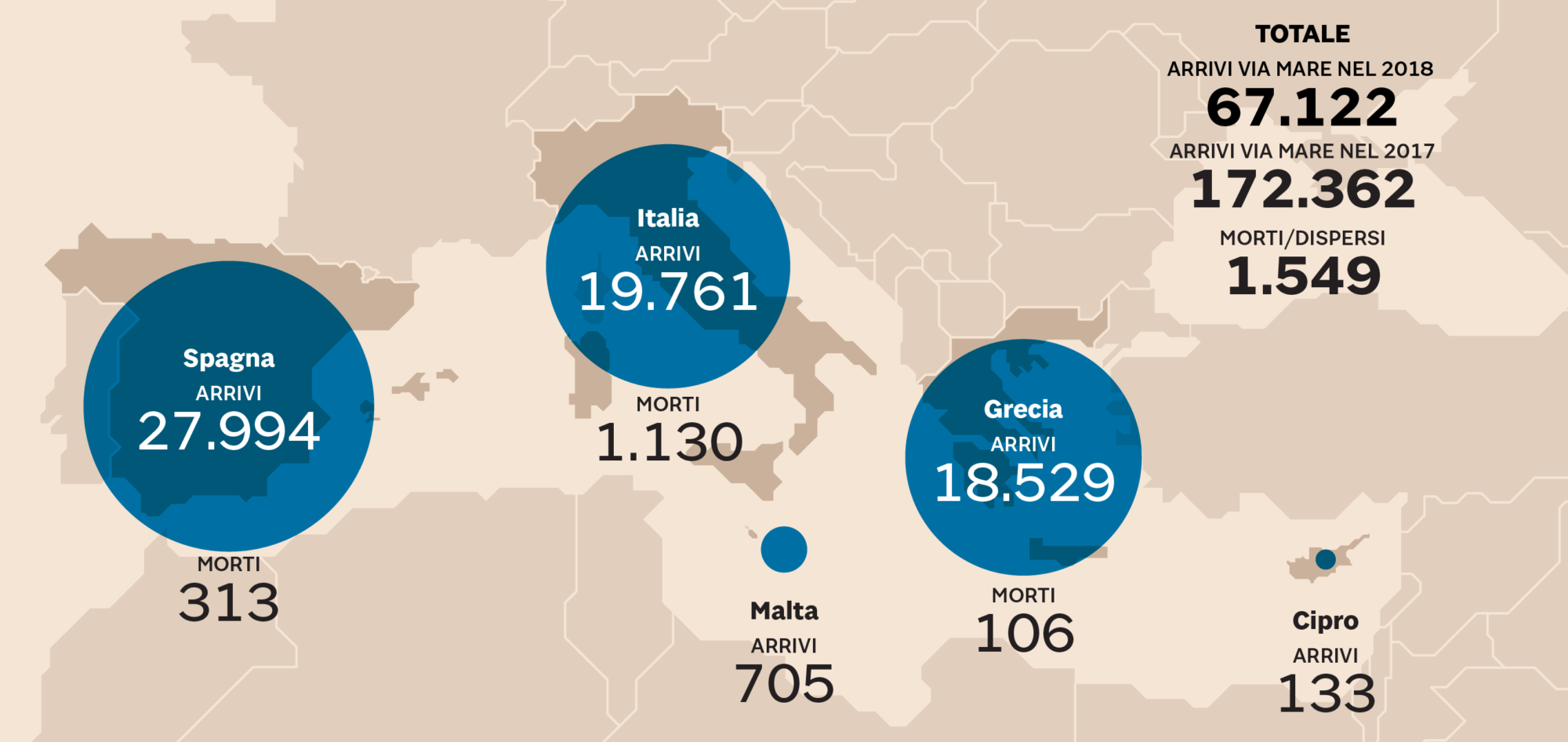This Sunday 9 September, all eyes were on Sweden, where elections for a new parliament were taking place and where populists, playing on widespread and rising hostility to migrants, seemed set to win a decisive victory. And they did. Almost one in five Swedish people voted for the Swedish Democrats (SD), the neo-nazi, anti-immigration party, giving it 17.6% of the votes:
Why has Sweden become the battlefield to watch? One of the world’s richest economies, it has drawn proportionately more migrants than most countries in Europe, along with Germany, when in 2015 Chancellor Merkel famously opened the doors to a “million immigrants”. And, in spite of an excellent “model” for integrating migrants in its economy and statistical “proof” that migrants have contributed actively to the rise in Swedish GNP – more about this below – people in Sweden have nevertheless been drawn to the siren songs of the populists. Just as they have in America, with Trump’s fight against immigration.
While the anti-immigration SD did not gain the 20 to 25 percent predicted by some polls before the elections, it is still a sizeable win that spells gridlock in Swedish politics.
Though early news indicate that the Swedish system of two blocks (left and right, each with around 40% of the votes) that has dominated Swedish politics over decades could be coming to an end. The outgoing Prime Minister Stefan Lovfen indicated that he would keep governing and would open to the center-right block. His party the Social Democrats, while losing some ground (it’s the worst result since 1908) still came out first at 28.3%. The problem is that the center-right leader Ulf Kristersson strongly feels he should be the one forming the new government.
Can this gridlock be resolved by the SD? The SD leader Jimmie Åkesson sees himself as a kingmaker. But other parties see him as definitely dangerous and don’t want to talk to him. Small wonder: SD has proposed a “Swexit” referendum to take Sweden out of the European Union and has vowed to end Sweden’s asylum policies.
The SD’s policies resonate in Swedish society, shaken by the flows of migrants that have strained housing, health care and welfare services. Public services came under pressure in 2015 when 163,000 asylum seekers were let in, proportionately the highest number in Europe in relation to the population. And the SD call resonates particularly in rural areas where industries and public services have been cut back. The party has repeatedly tried to link a rise in violence to immigrants, although official figures show no link.
In the photo: Comment made by former UKIP leader Nigel Farage on LBC radio on Monday 20 February, when he discussed the recent comments by US President Donald Trump about terrorism in Sweden. Source: BBC
Malmo, in spite of Nigel Farage’s claims, is not the rape capital of Europe. Rate of reported rapes are high in Sweden because of the way Swedish law is applied; but the rate in Malmo, and other urban centers, has not dramatically risen in recent years and has in fact declined from its peak in 2010, before the recent large increases in refugees. In short, there is not way to link
But the problem is bigger than Sweden. While such a win certainly signals another tightening of the screw on migrant inflows, more importantly, it threatens Europe’s future and the liberal values it stands for. In short, it marks a further rise in xenophobic populism.
Xenophobia is back in Europe
It is back in Europe with a vengeance. Because that is the right term for this type of populism, rooted in the hatred of the other. The term, derived from Greek, has deep roots in History. Indeed, the ancient Greeks were the first to give it a name. They called foreigners with the derogatory term “barbarian” and saw them as only fit to be slaves.
This formula – ascribing a rise in violence and a decrease in public services to immigrants – is exactly the policy of all populists across Europe, from Italy’s Matteo Salvini, Austria’s Sebastian Kurz, Poland’s Jaroslaw Kaczynski to Hungary’s Viktor Orban – spurred on by Steve Bannon who’s working hard to pull together all the European populists for a big win at the elections for the European Parliament in May 2019.
The populists’ aim is simple enough: kick the foreigners out. They won’t hear of managing the situation and integrating whoever can prove that they are able to work and contribute to national wealth. Integration is a dirty word, something they won’t even discuss.
The Swedish elections are a litmus test for liberal, democratic values, a test that is causing fear across Europe and should equally worry Americans. Because a strong win for populists in Sweden does two things:
- Confirm Trump and populist leaders like him around the world and not only in Europe, that populism rooted in anti-migrant sentiments is a winning card and that they should keep playing it;
- Lead to a rise in euro-skepticism and nationalism across Europe – or what used to be called chauvinism because you cannot grace this new phenomenon with the hallowed term of patriotism (although they do – but populists are masters at manipulating people’s emotions with the “right words” and spreading fake news).
The term “migrants wars” is bandied about as if flows of migrants were still on the rise, while they have in fact sharply fallen since the high in 2015. And that is the biggest piece of fake news that populists bank on.
A quick look at the facts is needed to dispel any doubts that migrant flows are rising.
The Migrant Crisis that Doesn’t Exist
Consider this diagram showing immigrants arrivals to Europe in 2018 (UN data) that was published by the Sole 24 Ore in Italy (disclosure: I am stationed in Rome), another country convulsed with sudden hatred for immigrants now that Matteo Salvini, the populist leader of the far-right League has become Minister of the Interior in the new government:
In the photo: The diagram shows immigrants, arrivals in 2018 (total: 67,122) – this compares to same period in 2017 that had a total more than double: 172,362. Note how Spain has become the main country of arrivals in 2018. Italy and Greece are nearly at the same level (19,761 for Italy, 18,529 for Greece) but ten times as many deaths (1,130 vs. 106), presumably because the sea trip to Greece is shorter and less dangerous. Source: International Immigration Organization – UN
Yet Salvini plays the card of the fake “migrant crisis”. His recent meeting with Hungary’s autocratic Prime Minister Orban shows exactly what he is up to. It’s a game of upping the ante, pretending there is a growing crisis when there isn’t. He is deliberately lying as a way to win votes.
No surprise there: Lying and making up fake crises are Trump’s – and populists’ – favorite ploys.
The rise in migrant arrivals in Spain, +114% in January-July 2018 compared to the same months in 2017, is attributed by Salvini’s fans to his tough policies of closing the borders to rescue ships. How they were re-routed to Spain was reported in all the news.
But two things are wrong with this narrative: first, it is only a matter of a few hundred migrants. Second, the number of arrivals to Spain had grown before Salvini took control of the government.
Moreover, the drop in arrivals in Italy in any case occurred during the previous leftist PD government – they were not due to Salvini but to Minniti, his predecessor at the Interior Ministry.
In short, Salvini’s tough policies have achieved no noticeable change in the situation. The drop had occured before and is not his doing.
The Long Shadow of Fake News and Misperceptions about Migrants
In spite of the reality that there is no longer a “migrant crisis”, fear has spread in Europe that we are at a watershed and that the next European Parliament elections in May 2019 will usher in a new era of “identity” politics. With the worst scenario of a euro-skeptic populist heading the European Parliament.
This denial of reality is rooted in two facts:
(1) fake news;
(2) widespread misperceptions regarding the real number of foreigners present in the country.
Regarding fake news, the pre-election period in Sweden was marked by them. Reuters reported that disinformation spread by far-right activists swept through the social networks; according to Oxford University researchers, one in three news articles shared online about the upcoming Swedish election came from websites publishing deliberately misleading information, most with a right-wing focus on immigration and Islam.
People are quick to believe fake news about migrants because they have the wrong perception of how many foreigners are in their country. For example, a recent survey of the Istituto Cattaneo found that Italians have the greatest propensity among Europeans to overestimate the presence of foreigners in Italy.
The Italians sampled in their survey were convinced that the number of non-European residents in Italy was 25% when the real figure is 7%. That is extraordinary gap between perception and reality rises with people’s ideological beliefs: People on the right were more given to exaggerate the number of foreigners present in Italy, up to 32.4%. Though everyone exaggerated the number, including leftists, that thought the level of foreigners stood at 18.5% of the total population.
What is true of Italians is true of the rest of Europeans. As the special EU investigation – the Eurobarometer on Integration in the EU – reported in April 2018:
Respondents also tend to overestimate the number of non-EU immigrants: in 19 out of the 28 Member States, the estimated proportion of immigrants in the population is at least twice the actual proportion and in some countries the ratio is much is higher.(Highlight added)
The Flop of European Solidarity: Italy is Left Alone
The only thing that is not a lie: On the question of migrants, Italy is still abandoned by Europe. They have flooded into Italy over decades, and nobody in Europe wanted them. France more than once closed its borders. Hungary raised a wall.
Overall, according to EU data. Italy had redistributed in Europe a total of 12,694 immigrants, next to nothing compared to the hundreds of thousands of migrants that flowed in since 2015. The countries that accepted the most were predictably Germany (5,436) and Sweden (1,392) while the Visegrad Group of countries were least inclined to accept migrants. Victor Orban’s country, Hungary, accepted none, even though Orban and Salvini are close buddies.
Undeterred, Salvini is determined not to let refugees on rescue ships disembark in Italy – not before Europe accepts to take them in. But in spite of recent prolonged meetings with 12 EU members countries, there is still no green light from Brussels.
Instead, the EU is moving to expand its border police with 10,000 new agents: that is the only positive sign of European solidarity. Not much.
Salvini doesn’t care, he’s doubling down on his position, saying he’s following the Australian “No Way” model.
He’s gone so far as to proposed a new law on immigration, a decree in 9 points that spells out everything he plans to do with migrants: lock them up, check them out and send them back. And if the process takes 18 months, so be it. He’ll keep them locked up all that time.
Amazing. Because locking up people is no way to solve the problem. And to think that the Swedish migrant model of integration actually worked…
The Swedish Migrant Model
Migrants are at the root of Swedish economic growth. As recently reported by Bloomberg, lost in the “political rhetoric” of the Swedish elections, is the story of the “bounce” that immigrants “delivered to the $540 billion Swedish economy:
Sweden’s rapid intake of huge numbers of refugees and migrants, about 600,000 in total over the past five years, has produced some of the highest growth rates in Europe and will also help it address the challenges of an otherwise aging population.
The facts speak for themselves. Gross domestic product increased more than 3 percent in the first two quarters of the year, which is considerably faster than the euro zone’s roughly 2 percent growth. Immigrants in Sweden have a labor participation rate of about 82 percent, some 4 percentage points higher than the EU average.
This remarkable GDP growth is linked to the thousands of work permits to a range of foreign-born people with needed skills, from information technology developers to berry pickers and cooks. All the job growth in the industrial sector last year was due to immigrant workers as well as 90 percent of new jobs in the welfare sector (health care and elderly care).
This said, Sweden did not easily absorb such large numbers of new workers – even though it has more than 100,000 job vacancies. As a result, unemployment among the foreign born is much higher, 20 percent compared to 6.8 percent overall. This fact is easy to exploit by the ideological right. For example, Joakim Ruist, in a recent report from the Expert Group on Public Economics, argued (without any evidence) that “refugees rarely have the right education or skills to match the needs of Swedish employers”.
Bottom line, it’s a long, arduous road to achieve integration, but it is the only way to go if we want to resolve the immigration problem. Kicking them out is no solution. What is needed is to address the problem of those who are already here, in Europe. And in the long-run, integrating them will pay for itself, as numerous studies show. Refugees, if handled right, are not a cost, they are a benefit.
Editors Note: The opinions expressed here by Impakter.com columnists are their own, not those of Impakter.com – Featured Image: Migrants in Hungary near the Serbian border, August 2015 Credit: Gémes Sándor/SzomSzed Creative Commons












